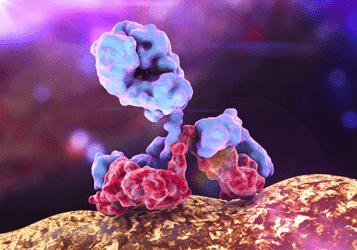- Home
- Products
- Customized ADCs
- CD44
- Anti-CD44 (Bivatuzumab)-SPDB-DM4 ADC
Anti-CD44 (Bivatuzumab)-SPDB-DM4 ADC (CAT#: ADC-W-2543)
This ADC product is comprised of an anti-CD44 monoclonal antibody conjugated via a SPDB linker to DM4. The DM4 is targeted to certain cancers by immunerecognition and delivered into cancer cells via receptor mediated endocytosis. Within the cell, DM1 binds to tubulins, interrupts microtubule dynamics, and subsequently, induces cell death.
- ADC Target
- ADC Antibody
- ADC Linker
- ADC payload drug
- Name
- CD44
- Alternative Names
- CD44; CD44 molecule (Indian blood group); CD44 antigen (homing function and Indian blood group system) , MDU2, MDU3, MIC4; CD44 antigen; CD44R; chondroitin sulfate proteoglycan 8; CSPG8; HCELL; hematopoietic cell E and L selectin ligand; IN; MC56; Pgp1; epican; Hermes antigen; hyaluronate receptor; phagocytic glycoprotein 1; heparan sulfate proteoglycan; cell surface glycoprotein CD44; extracellular matrix receptor III; GP90 lymphocyte homing/adhesion receptor; hematopoietic cell E- and L-selectin ligand; homing function and Indian blood group system; LHR; MDU2; MDU3; MIC4; CDW44; HUTCH-I; ECMR-III; MGC10468;
- Target Entrez Gene ID
- 960
- Target UniProt ID
- P16070
- Overview
- The protein encoded by this gene is a cell-surface glycoprotein involved in cell-cell interactions, cell adhesion and migration. It is a receptor for hyaluronic acid (HA) and can also interact with other ligands, such as osteopontin, collagens, and matrix metalloproteinases (MMPs). This protein participates in a wide variety of cellular functions including lymphocyte activation, recirculation and homing, hematopoiesis, and tumor metastasis. Transcripts for this gene undergo complex alternative splicing that results in many functionally distinct isoforms, however, the full length nature of some of these variants has not been determined. Alternative splicing is the basis for the structural and functional diversity of this protein, and may be related to tumor metastasis.
- Overview
- Humanized Anti-CD44 IgG1 antibody, Bivatuzumab
- Generic name
- Bivatuzumab
- Host animal
- Mouse
- Name
- SPDB (N-succinimidyl-4-(2-pyridyldithio)butyrate)
- Description
- Disulfide Linkers, are extensively exploited as a chemically labile linkage. Since the release of disulfide-linked drugs requires a cytoplasmic thiol cofactor, such as glutathione (GSH). Disulfides maintain stable at physiological pH and only when ADCs are internalized inside cells, the cytosol provides reducing environment including intracellular enzyme protein disulfide isomerase, or similar enzymes, drugs can be released.
- Name
- DM4 (N2'-Deacetyl-N2'-(4-mercapto-4-methyl-1-oxopentyl)maytansine)
- Description
- Derived from Maytansinoid,a group of cytotoxins structurally similar to rifamycin, geldanamycin, and ansatrienin. The eponymous natural cytotoxic agent maytansine is a 19-member lactam (ansa macrolide) structure originally isolated from the Ethiopian shrub Maytenus ovatus. Maytansinoids can bind to tubulin at or near the vinblastine-binding site, which interfere the formation of microtubules and depolymerize already formed microtubules, inducing mitotic arrest in the intoxicated cells.
For Research Use Only. NOT FOR CLINICAL USE.
Related Products
- Anti-CD19-Mc-MMAE ADC-1 (CAT#: ADC-W-323)
- Anti-ACVR2B (Bimagrumab)-MC-Vc-PAB-SN38 ADC (CAT#: ADC-W-654)
- Anti-IGF1R (Robatumumab)-MC-MMAF ADC (CAT#: ADC-W-1252)
- Anti-TNFRSF8-DIBO-doxorubicin ADC-12 (CAT#: ADC-W-340)
- Anti-CD80 (Galiximab)-MC-Vc-PAB-DMEA-(PEG2)-duocarmycin SA ADC (CAT#: ADC-W-961)
- Anti-S1P (Sonepcizumab)-MC-Vc-PAB-MMAE ADC (CAT#: ADC-W-2435)
- Anti-HBV (Tuvirumab)-MC-Vc-PAB-SN38 ADC (CAT#: ADC-W-2100)
- Anti-SOST (Blosozumab)-MC-MMAF ADC (CAT#: ADC-W-1768)
- Anti-MS4A1 (Ublituximab)-MC-Vc-PAB-DMEA-(PEG2)-duocarmycin SA ADC (CAT#: ADC-W-1561)
- Anti-CD37-SMCC-DM1 ADC (CAT#: ADC-W-473)
Published Data
+ Submit Publications

Scientific Resources
Customer Reviews and FAQs
There are currently no Customer reviews or questions for ADC-W-2543. Click the button above to contact us or submit your feedback about this product.
Quick Links
Other Products
Same Target
Same Linker
Same Payload
| CAT# | Product Name | Linker | Payload |
| ADC-W-2544 | Anti-CD44 (Bivatuzumab)-MC-MMAF ADC | MC (maleimidocaproyl) | MMAF |
| ADC-W-2546 | Anti-CD44 (Bivatuzumab)-MC-Vc-PAB-SN38 ADC | MC-Vc-PAB (maleimidocaproyl-valine-citrulline-p-aminobenzoyloxycarbonyl) | SN-38 (7-ethyl-10-hydroxycamptothecin) |
| ADC-W-541 | Anti-CD44-DM1 ADC | DM1 (N2’-Deacetyl-N2’-(3-mercapto-1-oxopropyl)maytansine) | |
| ADC-W-2545 | Anti-CD44 (Bivatuzumab)-MC-Vc-PAB-MMAE ADC | MC-Vc-PAB (maleimidocaproyl-valine-citrulline-p-aminobenzoyloxycarbonyl) | MMAE |
| ADC-W-2547 | Anti-CD44 (Bivatuzumab)-MC-Vc-PAB-DMEA-(PEG2)-duocarmycin SA ADC | MC-Vc-PAB-DMEA-(PEG2) | duocarmycin SA |
| CAT# | Product Name | Linker | Payload |
| ADC-W-2590 | Anti-EGFR (Cetuximab)-SPDB-DM4 ADC | SPDB (N-succinimidyl-4-(2-pyridyldithio)butyrate) | DM4 (N2'-Deacetyl-N2'-(4-mercapto-4-methyl-1-oxopentyl)maytansine) |
| ADC-W-469 | Anti-CA6-SPDB-DM4 ADC | SPDB (N-succinimidyl-4-(2-pyridyldithio)butyrate) | DM4 (N2'-Deacetyl-N2'-(4-mercapto-4-methyl-1-oxopentyl)maytansine) |
| ADC-W-2605 | Anti-ITGB3 (Tadocizumab)-SPDB-DM4 ADC | SPDB (N-succinimidyl-4-(2-pyridyldithio)butyrate) | DM4 (N2'-Deacetyl-N2'-(4-mercapto-4-methyl-1-oxopentyl)maytansine) |
| ADC-W-480 | Anti-CD33-SPDB-DM4 ADC-6 | SPDB (N-succinimidyl-4-(2-pyridyldithio)butyrate) | DM4 (N2'-Deacetyl-N2'-(4-mercapto-4-methyl-1-oxopentyl)maytansine) |
| ADC-W-2616 | Anti-MS4A1-SPDB-DM4 ADC | SPDB (N-succinimidyl-4-(2-pyridyldithio)butyrate) | DM4 (N2'-Deacetyl-N2'-(4-mercapto-4-methyl-1-oxopentyl)maytansine) |
| CAT# | Product Name | Linker | Payload |
| ADC-W-2616 | Anti-MS4A1-SPDB-DM4 ADC | SPDB (N-succinimidyl-4-(2-pyridyldithio)butyrate) | DM4 (N2'-Deacetyl-N2'-(4-mercapto-4-methyl-1-oxopentyl)maytansine) |
| ADC-W-2621 | Anti-NCAM1 (Lorvotuzumab )-SPDB-DM4 ADC | SPDB (N-succinimidyl-4-(2-pyridyldithio)butyrate) | DM4 (N2'-Deacetyl-N2'-(4-mercapto-4-methyl-1-oxopentyl)maytansine) |
| ADC-W-480 | Anti-CD33-SPDB-DM4 ADC-6 | SPDB (N-succinimidyl-4-(2-pyridyldithio)butyrate) | DM4 (N2'-Deacetyl-N2'-(4-mercapto-4-methyl-1-oxopentyl)maytansine) |
| ADC-W-320 | Anti-SDC1-SPDB-DM4 ADC | SPDB (N-succinimidyl-4-(2-pyridyldithio)butyrate) | DM4 (N2'-Deacetyl-N2'-(4-mercapto-4-methyl-1-oxopentyl)maytansine) |
| ADC-W-422 | Anti-ITGAV-SPDB-DM4 ADC | SPDB (N-succinimidyl-4-(2-pyridyldithio)butyrate) | DM4 (N2'-Deacetyl-N2'-(4-mercapto-4-methyl-1-oxopentyl)maytansine) |
Online Inquiry
Welcome! For price inquiries, please feel free to contact us through the form on the left side. We will get back to you as soon as possible.



